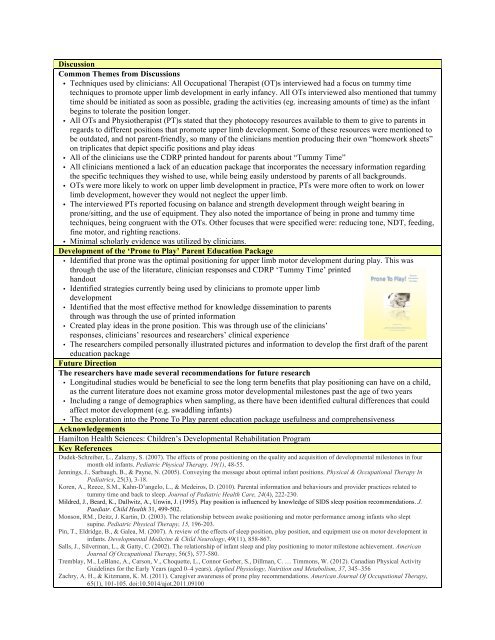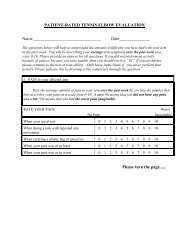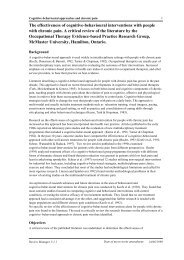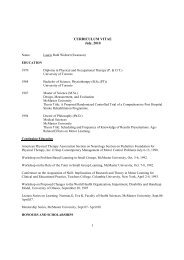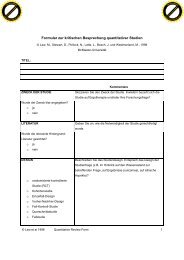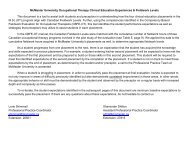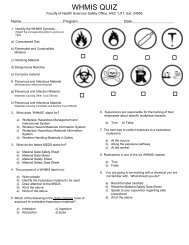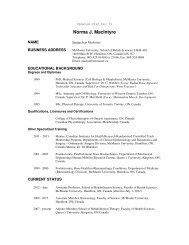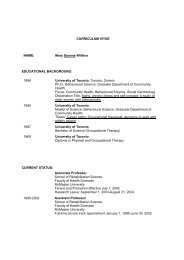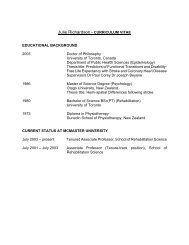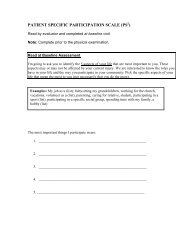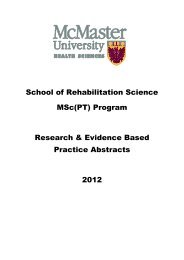Evidence Based Practice Symposium - McMaster University
Evidence Based Practice Symposium - McMaster University
Evidence Based Practice Symposium - McMaster University
Create successful ePaper yourself
Turn your PDF publications into a flip-book with our unique Google optimized e-Paper software.
Discussion<br />
Common Themes from Discussions<br />
• Techniques used by clinicians: All Occupational Therapist (OT)s interviewed had a focus on tummy time<br />
techniques to promote upper limb development in early infancy. All OTs interviewed also mentioned that tummy<br />
time should be initiated as soon as possible, grading the activities (eg. increasing amounts of time) as the infant<br />
begins to tolerate the position longer.<br />
• All OTs and Physiotherapist (PT)s stated that they photocopy resources available to them to give to parents in<br />
regards to different positions that promote upper limb development. Some of these resources were mentioned to<br />
be outdated, and not parent-friendly, so many of the clinicians mention producing their own “homework sheets”<br />
on triplicates that depict specific positions and play ideas<br />
• All of the clinicians use the CDRP printed handout for parents about “Tummy Time”<br />
• All clinicians mentioned a lack of an education package that incorporates the necessary information regarding<br />
the specific techniques they wished to use, while being easily understood by parents of all backgrounds.<br />
• OTs were more likely to work on upper limb development in practice, PTs were more often to work on lower<br />
limb development, however they would not neglect the upper limb.<br />
• The interviewed PTs reported focusing on balance and strength development through weight bearing in<br />
prone/sitting, and the use of equipment. They also noted the importance of being in prone and tummy time<br />
techniques, being congruent with the OTs. Other focuses that were specified were: reducing tone, NDT, feeding,<br />
fine motor, and righting reactions.<br />
• Minimal scholarly evidence was utilized by clinicians.<br />
Development of the ‘Prone to Play’ Parent Education Package<br />
• Identified that prone was the optimal positioning for upper limb motor development during play. This was<br />
through the use of the literature, clinician responses and CDRP ‘Tummy Time’ printed<br />
handout<br />
• Identified strategies currently being used by clinicians to promote upper limb<br />
development<br />
• Identified that the most effective method for knowledge dissemination to parents<br />
through was through the use of printed information<br />
• Created play ideas in the prone position. This was through use of the clinicians’<br />
responses, clinicians’ resources and researchers’ clinical experience<br />
• The researchers compiled personally illustrated pictures and information to develop the first draft of the parent<br />
education package<br />
Future Direction<br />
The researchers have made several recommendations for future research<br />
• Longitudinal studies would be beneficial to see the long term benefits that play positioning can have on a child,<br />
as the current literature does not examine gross motor developmental milestones past the age of two years<br />
• Including a range of demographics when sampling, as there have been identified cultural differences that could<br />
affect motor development (e.g. swaddling infants)<br />
• The exploration into the Prone To Play parent education package usefulness and comprehensiveness<br />
Acknowledgements<br />
Hamilton Health Sciences: Children’s Developmental Rehabilitation Program<br />
Key References<br />
Dudek-Schreiber, L., Zalazny, S. (2007). The effects of prone positioning on the quality and acquisition of developmental milestones in four<br />
month old infants. Pediatric Physical Therapy, 19(1), 48-55.<br />
Jennings, J., Sarbaugh, B., & Payne, N. (2005). Conveying the message about optimal infant positions. Physical & Occupational Therapy In<br />
Pediatrics, 25(3), 3-18.<br />
Koren, A., Reece, S.M., Kahn-D’angelo, L., & Medeiros, D. (2010). Parental information and behaviours and provider practices related to<br />
tummy time and back to sleep. Journal of Pediatric Health Care, 24(4), 222-230.<br />
Mildred, J., Beard, K., Dallwitz, A., Unwin, J. (1995). Play position is influenced by knowledge of SlDS sleep position recommendations. J.<br />
Paediatr. Child Health 31, 499-502.<br />
Monson, RM., Deitz, J. Kartin, D. (2003). The relationship between awake positioning and motor performance among infants who slept<br />
supine. Pediatric Physical Therapy, 15, 196-203.<br />
Pin, T., Eldridge, B., & Galea, M. (2007). A review of the effects of sleep position, play position, and equipment use on motor development in<br />
infants. Developmental Medicine & Child Neurology, 49(11), 858-867.<br />
Salls, J., Silverman, L., & Gatty, C. (2002). The relationship of infant sleep and play positioning to motor milestone achievement. American<br />
Journal Of Occupational Therapy, 56(5), 577-580.<br />
Tremblay, M., LeBlanc, A., Carson, V., Choquette, L., Connor Gorber, S., Dillman, C. … Timmons, W. (2012). Canadian Physical Activity<br />
Guidelines for the Early Years (aged 0–4 years). Applied Physiology, Nutrition and Metabolism, 37, 345–356<br />
Zachry, A. H., & Kitzmann, K. M. (2011). Caregiver awareness of prone play recommendations. American Journal Of Occupational Therapy,<br />
65(1), 101-105. doi:10.5014/ajot.2011.09100


